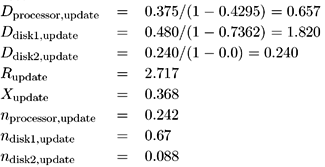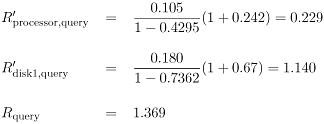13.7 Mixed Models
| A mixed model with R classes of customers has C closed classes and O open classes, where R = C + O. In fact, a mixed model can be viewed as a combination of two separate submodels, a closed model and an open model, that happen to share the common resources of a computer system, as depicted in Figure 13.8. The load intensity of a mixed queuing network model is defined by a pair of vectors
The basic approach to solve a mixed multiclass model is to solve their submodels independently, but with adjusted service demands to represent the impact on each other. Because the device utilizations do not depend on the closed submodel, the open submodel is solved first and the device utilizations due to the open classes is obtained. The effect of contention at a server due to customers of different submodels is represented by elongating the service demands for the closed submodel. To elongate the service demands appropriately, they are multiplied by a factor that is proportional to the inverse of the idle time remaining from the open submodel [i.e., 1/(1 Ui,open)] [1]). The closed submodel with the elongated service demands is then solved using the MVA algorithm. Response times of the open submodels are affected by the closed submodel. To account for this interference, the average queue lengths of closed customers is used in the calculation of response times of open customers (i.e., Example 13.3.Reconsider the simple two-class model described in Section 13.3. Suppose now that the way of viewing the system has been changed by deciding to represent the query class as a transaction class, with arrival rate equal to 4.09 tps. Table 13.11 shows the input parameters of the mixed model. By following the algorithm of Figure 13.9, the first step is to calculate the utilization due to the open class with l1 = 4.09 tps.
Using the utilizations due to the open class, the adjusted service demands are calculated for the closed submodel. By applying the MVA algorithm to solve the closed submodel with N1 = (1), the following are obtained:
To compute the average response time of the open submodel, the queue lengths of the closed submodel are used to reflect the contention in the servers.
As with the other types of models, mixed queuing networks can be used easily for predicting purposes. For example, what is the performance of the query transactions if the load of update jobs is doubled? In this case, it is only necessary to change the number of update transactions in the system from 1 to 2 and re-solve the model. The new value for the response time of query transactions is 1.947, which corresponds to a 42% increase. Figure 13.8. Multiclass mixed models. Figure 13.9. Algorithm for mixed multiclass models.
| ||||||||||||||||||||||||||||||||||||||||||
EAN: 2147483647
Pages: 166





